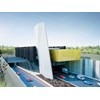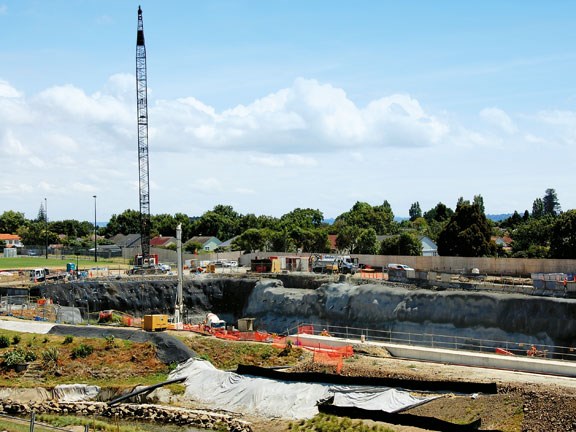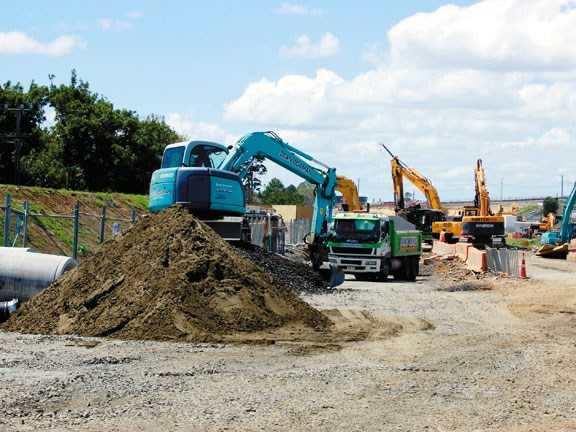Waterview Connection











|

|

|

|

|
The construction sites at both the southern and northern approaches of the proposed Waterview tunnel are humming. At the south site in particular, enough work has been done that a spectator can already imagine the elegant entrance of the long-awaited tunnel, which will shorten travelling times between the airport and the central city by up to 15 minutes when it opens in 2017. Jenny Pretorius visited the site.

|
|
Waterview Connection
|
Work on the Waterview Connection project, a semi-underground road link running between the Great North Road interchange in Waterview and Maioro St in New Windsor, is progressing briskly and according to schedule.
The $1.4b project, the NZTA's largest, most expensive, and most challenging project to date, will integrate an extra 4.8km of six-lane motorway through and beneath the city's Western suburbs, linking State Highways 16 and 20, to complete the Auckland Western Ring Route around the city.
The construction of the connection incorporates several earthworks projects. These are building two 2.4km-long 14.1m-diameter bored tunnels, each of which will carry three lanes of traffic; connecting the tunnels to SH20 to the south and SH16 to the north; building six new road bridges; and building new recreational facilities at both ends including walking and cycling connections, sports fields, skate parks and basketball courts.
The southern end
At the southern end of the project, work is focused on having the site ready for the arrival of the Herrenknecht tunnel boring machine in June this year, and the start of tunnelling in October. The work site comprises the area between Maioro Street — where SH20 now ends — and the location of the tunnels' southern portals in Alan Wood Reserve in Owairaka.
The work involves two main projects and several other key enabling tasks. Firstly, the team is building a motorway link between the proposed tunnels and SH20, which will create a direct link from the site to the motorway for trucking spoil away and bringing in supplies, including the tunnel boring machine and tunnel lining segments.
Secondly, the team is building the 45-metre-wide southern approach trench in the Alan Wood Reserve, which requires excavation to a depth of 30 metres, initially through a 15-metre-thick layer of very hard basalt.
The team has now reached the floor of the lava flow at the tunnel headwall, halfway to the point 30 metres below the surface where the tunnel boring machine will begin its slow trek to Waterview in October 2013. Approximately 100,000 cubic metres of this basalt were removed. Basalt extraction was completed at a rate of 1000m³ a day, using a combination of rock breaking, drilling, and blasting designed to minimise disruption to the community around the site.
The key enabling tasks include the construction of a motorway overpass to take Richardson Road over the motorway; construction of an overpass above Oakley Creek (Auckland's longest freshwater creek); realignment and improvement of other sections of the Oakley Creek; relocation of a major Watercare sewer away from the motorway alignment; construction of storm water treatment ponds; and construction of a major spoil handling facility.
Work on improving parts of Alan Wood Reserve through landscaping are underway too. Work on the Richardson Road bridge and the relocation of the sewer is well-advanced.
The northern end
At the northern end of the project, work is focused on an approximately five-hectare area parallel to Great North Road, incorporating part of the former Waterview Reserve and Cowley Street. About 100 houses have been removed from the area, a fifth of which were relocated rather than demolished. In addition, road and pedestrian routes have been changed to prepare the area for work on the trench approaching the northern tunnel.
This work has now begun. The trench will be built using the diaphragm wall method, as used for the New Lynn rail trench and Victoria Park Tunnel. The site has a bentonite plant. The bentonite is pumped into the trench excavation hole to condition the sandy soil and make it easier for the excavator to remove the spoil.
The northern tunnel portal is being prepared to the west of Great North Road. This is a significant development from what was originally proposed, as it reflects the ability to continue the bored tunnel underneath this major arterial, rather than trench across it. Not only will this reduce disruption for commuters, it dimishes the construction footprint by removing the need for temporarily occupying the neighbouring Waterview Glades area.
From this portal, the motorway will rise up in the form of four ramps to connect in to the existing SH16 interchanges, thereby completing the Western Ring Route.
More than just another tunnel
Completing the Western Ring Route is of huge strategic importance to the country's economic growth, and as such, has been nominated by the New Zealand Government as one of 7 Roads of National Significance.
Currently all Auckland through-traffic, which can reach daily vehicle counts of up to 200,000, must use State Highway 1, passing through the city's central motorway junction and over the Auckland Harbour Bridge. By creating a viable motorway alternative for through-traffic, the Western Ring Route will enhance safety, journey-time reliability throughout the region, and reduce the burden on the Harbour Bridge.
The Waterview Connection will also create a direct motorway route from the CBD to the airport, reducing traffic on local roads and cutting travel time between the two points by over 15 minutes.
An unexpected bonus is that not all the work will be for the unique benefit of motorway users. The Waterview Connection project will integrate road bridges, cycle ways and pedestrian bridges within a suite of urban design, landscaping, and environmental enhancements. The inclusion of these elements will be complemented by on-going community involvement, as the NZTA commits to delivering its biggest project with maximum benefit and minimum disruption to the local community.
To do this, the NZTA has appointed a specialist team, known as the Well-Connected Alliance (WCA), to manage the design, construction, and operation of the Waterview Connection. Bringing together the NZTA, Fletcher Construction, McConnell Dowell Constructors, Parsons Brinkerhoff NZ, Beca Infrastructure, Tonkin and Taylor, and Japanese construction company Obayashi Corporation, the WCA has the knowledge and solid, home-grown reputation of leading Kiwi engineering companies with the world-class tunnelling expertise of its international partners.
The Waterview Connection project is the first to be approved by the Environmental Protection Authority (EPA), through a Board of Inquiry (BoI) hearing.
Feel free to make a comment or ask us a question about this story on the Deals On Wheels  page.
page.
For the latest reviews, subscribe to our Deals On Wheels magazine here.
Keep up to date in the industry by signing up to Deals on Wheels' free newsletter or liking us on Facebook.

.jpg)

.jpg)

.jpg)

